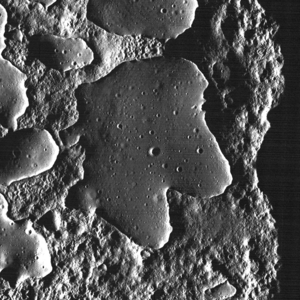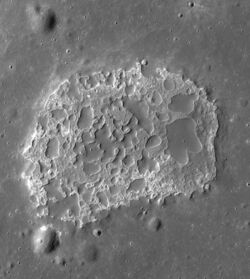Astronomy:Mons Agnes
| Mons Agnes | |
|---|---|
 Mons Agnes. Very low Sun (6.6°) makes the relief well-seen. Width of the photo is 1 km. Image by LRO, 2009. | |
| Highest point | |
| Elevation | 30 m |
| Listing | Lunar mountains |
| Coordinates | [ ⚑ ] 18°40′N 5°20′E / 18.66°N 5.34°E |
| Naming | |
| English translation | Feminine name Agnes |
| Language of name | Greek |
| Geography | |
| Location | the Moon |
Mons Agnes is a hill ("mountain") on the Moon, in Lacus Felicitatis, inside the crater-like feature Ina, at [ ⚑ ] 18°40′N 5°20′E / 18.66°N 5.34°E. It has a maximal width of approximately 650 m[1] (the smallest of all named lunar mountains as of 2014[2]). Its height is more difficult to determine; from Apollo 15 images it was determined as about 30 m,[1] but a newer map, based on LRO photos, gives about 10 m.[3]
Mons Agnes (and the entire Ina crater) was discovered on the photos made by Apollo 15 from lunar orbit in 1971.[4] In 1974 NASA published a topophotomap where its name first appeared: it received Greek feminine name Agnes.[1] In 1979 this name (with a term Mons – "mountain") was adopted by the International Astronomical Union.[5]
Mons Agnes is one of several dozens of similar hills inside Ina (but one of the largest). Their origin, as for Ina on the whole, remains enigmatic.[6][7]
References
- ↑ 1.0 1.1 1.2 "Sheet 41C3S1(10) Ina". NASA lunar topophotomap (based on Apollo 15 photos). Scale 1:10,000 (1 ed.). Prepared and published by the Defence Mapping Agency Topographic Center, Washington, D.C.. 1974. http://www.lpi.usra.edu/resources/mapcatalog/topophoto/41C3S1.
- ↑ "Moon. Mons, montes. Nomenclature search results". International Astronomical Union (IAU) Working Group for Planetary System Nomenclature (WGPSN). http://planetarynames.wr.usgs.gov/SearchResults?target=MOON&featureType=Mons,%20montes.
- ↑ Garry, W. B.; Robinson, M. S.; Zimbelman, J. R.; Bleacher, J. E. et al. (November 2012). "The origin of Ina: Evidence for inflated lava flows on the Moon". Journal of Geophysical Research 117: E00H31. doi:10.1029/2011JE003981. Bibcode: 2012JGRE..117.0H31G. http://wvaughan.org/ina/garry-2012.pdf. Retrieved 2014-11-07. (the map from this work)
- ↑ Whitaker, E.A. (1972). "An unusual mare feature". Apollo 15 Preliminary Science Report (NASA Special Publication 289). pp. 25-84–25-85. http://wvaughan.org/ina/whitaker-1972.pdf. Retrieved 2014-11-07.
- ↑ "Mons Agnes". Gazetteer of Planetary Nomenclature. USGS Astrogeology Research Program.
- ↑ Chan, N. W.; Vaughan, W. M.; Head, J. W. (March 2014). "Lunar Ina-Like Features: Maps and Morphometry". 45th Lunar and Planetary Science Conference, Held 17–21 March 2014 at the Woodlands, Texas. LPI Contribution No. 1777, P.1001 (1777): 1001. Bibcode: 2014LPI....45.1001C. http://www.hou.usra.edu/meetings/lpsc2014/pdf/1001.pdf. (poster)
- ↑ Robinson, M. S.; Thomas, P. C.; Braden, S. E.; Lawrence, S. J. et al. (March 2010). "High Resolution Imaging of Ina: Morphology, Relative Ages, Formation". 41st Lunar and Planetary Science Conference, Held March 1–5, 2010 in the Woodlands, Texas. LPI Contribution No. 1533, P.2592 (1533): 2592. Bibcode: 2010LPI....41.2592R. http://www.lpi.usra.edu/meetings/lpsc2010/pdf/2592.pdf.
External links
- Interactive map of Mons Agnes and the neighbourhood
- Set of high-resolution interactive maps of the region
- Map of LAC-41 quadrangle
- Mons Agnes on The-Moon Wiki
- The Enigmatic Lunar Surface Feature Called "Ina"
 |


